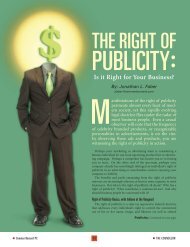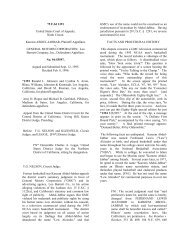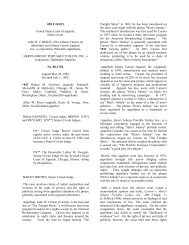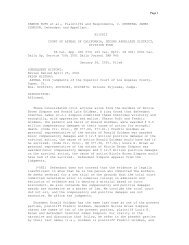Toney v. L'Oreal - Right Of Publicity
Toney v. L'Oreal - Right Of Publicity
Toney v. L'Oreal - Right Of Publicity
Create successful ePaper yourself
Turn your PDF publications into a flip-book with our unique Google optimized e-Paper software.
een preempted by federal law. Section 301 of the<br />
Copyright Act delineates two conditions which, if<br />
met, require the preemption of a state-law claim in<br />
favor of the rights and remedies available under federal<br />
law. Section 301(a) states:<br />
On and after January 1, 1978, all legal or equitable<br />
rights that are equivalent to any of the exclusive<br />
rights within the general scope of copyright as<br />
specified by section 106 in works of authorship<br />
that are fixed in a tangible medium of expression<br />
and come within the subject matter of copyright as<br />
specified by section[ ] 102... are governed exclusively<br />
by this title. Thereafter, no person is entitled<br />
to any such right or equivalent right in any such<br />
work under the common law or statutes of any<br />
State.<br />
17 U.S.C. § 301(a). We will take the questions in<br />
reverse order, first determining whether the work at<br />
issue is fixed in a tangible form and whether it comes<br />
within the subject matter of copyright as specified in<br />
§ 102. Second, we consider whether the right is<br />
equivalent to the general copyright protections which<br />
are set out in § 106.<br />
Section 102 of the Act defines the subject matter of<br />
copyright as “original works of authorship fixed in<br />
any tangible medium of expression,” including “pictorial”<br />
works. 17 U.S.C. § 102(a). The Act's definitional<br />
section explains that a work is “fixed” in a tangible<br />
medium of expression “when its embodiment in<br />
a copy ... is sufficiently permanent or stable to permit<br />
it to be perceived, reproduced, or otherwise communicated<br />
for a period of more than transitory duration.”<br />
17 U.S.C. § 101.<br />
[5] The second aspect of the test requires a showing<br />
that the right to be enforced is “equivalent” to any of<br />
the rights set forth in § 106. The notes and commentary<br />
accompanying § 106 make it clear that copyright<br />
holders have five exclusive and fundamental rights:<br />
reproduction, adaptation, publication, performance,<br />
and display. FN3 17 U.S.C. § 106. A copyright is<br />
*910 violated or infringed when, without permission,<br />
someone other than the copyright holder exercises<br />
one of these fundamental rights. Put differently, to<br />
avoid preemption, a state law must regulate conduct<br />
that is qualitatively distinguishable from that governed<br />
by federal copyright law-i.e., conduct other<br />
than reproduction, adaptation, publication, performance,<br />
and display. See, e.g., Trandes Corp. v. Guy<br />
F. Atkinson Co., 996 F.2d 655, 659-60 (4th<br />
Cir.1993); 1 Melville B. Nimmer & David Nimmer,<br />
NIMMER ON COPYRIGHT § 1.01[B] [1] (1999).<br />
FN3. Section 106 states:<br />
[T]he owner of copyright under this title<br />
has the exclusive rights to do and to authorize<br />
any of the following:<br />
(1) to reproduce the copyrighted work in<br />
copies or phonorecords;<br />
(2) to prepare derivative works based<br />
upon the copyrighted work;<br />
(3) to distribute copies or phonorecords of<br />
the copyrighted work to the public by sale<br />
or other transfer of ownership, or by<br />
rental, lease, or lending;<br />
(4) in the case of literary, musical, dramatic,<br />
and choreographic works, pantomimes,<br />
and motion pictures and other<br />
audiovisual works, to perform the copyrighted<br />
work publicly;<br />
(5) in the case of literary, musical, dramatic,<br />
and choreographic works, pantomimes,<br />
and pictorial, graphic, or sculptural<br />
works, including the individual images<br />
of a motion picture or other audiovisual<br />
work, to display the copyrighted<br />
work publicly; and<br />
(6) in the case of sound recordings, to perform<br />
the copyrighted work publicly by<br />
means of a digital audio transmission.<br />
[6][7] Applying the facts of this case to the requirements<br />
for preemption, we find that <strong>Toney</strong>'s identity is<br />
not fixed in a tangible medium of expression. There<br />
is no “work of authorship” at issue in <strong>Toney</strong>'s right of<br />
publicity claim. A person's likeness-her persona-is<br />
not authored and it is not fixed. The fact that an image<br />
of the person might be fixed in a copyrightable<br />
photograph does not change this. From this we must<br />
also find that the rights protected by the IRPA are not<br />
“equivalent” to any of the exclusive rights within the







